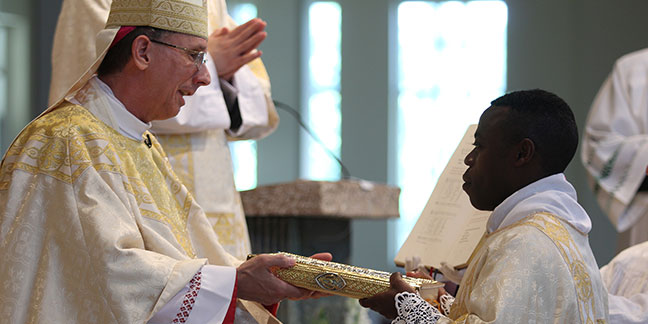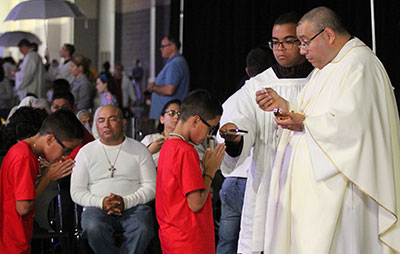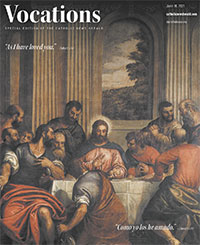‘Here to serve God’
 Deacon Joseph Wasswa receives the Book of the Gospels from Bishop Peter Jugis during the transitional diaconate Mass July 24, 2020. He will be ordained to the priesthood Saturday, June 19, at St. Mark Church in Huntersville. Wasswa, who is from Uganda, reflects the growing diversity in the diocese, which now numbers more than 515,000 people. (SueAnn Howell | Catholic News Herald)The Diocese of Charlotte now counts a Catholic population surpassing 515,000, served by an increasing number of priests and deacons – both natives of North Carolina and clergy who have come here from all over the world. They minister in the model of St. Joseph, quietly going about the work of serving God and His Church.
Deacon Joseph Wasswa receives the Book of the Gospels from Bishop Peter Jugis during the transitional diaconate Mass July 24, 2020. He will be ordained to the priesthood Saturday, June 19, at St. Mark Church in Huntersville. Wasswa, who is from Uganda, reflects the growing diversity in the diocese, which now numbers more than 515,000 people. (SueAnn Howell | Catholic News Herald)The Diocese of Charlotte now counts a Catholic population surpassing 515,000, served by an increasing number of priests and deacons – both natives of North Carolina and clergy who have come here from all over the world. They minister in the model of St. Joseph, quietly going about the work of serving God and His Church.
The diocese ordained its first priest in 1974, only two years after it was established, and since then the number of clergy has continued to grow as the diocese has grown.
Prayers and unwavering support from the faithful – seeds planted in fertile ground – have brought the Presence of Christ to every corner of western North Carolina.
Today, that ground is more diverse than ever – with diocesan and other priests offering Masses in the Roman rite (both Ordinary and Extraordinary forms), Maronite rite, Ukrainian Greek rite, Syro-Malabar rite and Ge’ez rite. Ordinary Form Masses are said routinely in English, Spanish, Vietnamese, Korean and Hmong; additional Masses are also offered periodically in Igbo and Polish.
In 92 parishes and missions across western North Carolina, 124 priests and 133 deacons are at work serving the people of God, with dozens more in formation for future ordination. In this guide, you’ll read stories about some of them – priest candidates from Uganda and Mexico, and jubilarians from seven U.S. states as well as Colombia, India and Vietnam.
The diocese embraces this diversity of cultures, languages and people. Bishop Peter Jugis has cited it as a sign of the Holy Spirit at work, noting in a 2017 Mass for priest jubilarians: “This is Catholicism … It is the one, holy, catholic and apostolic Church, and it’s all happening right here.”
‘God looks on the heart, and in St. Joseph He recognized the heart of a father, able to give and generate life in the midst of daily routines. Vocations have this same goal: to beget and renew lives every day.’
Pope Francis. 2021 World Day of Prayer for Vocations
PRIESTLY FORMATION
In addition to the growing diversity from incoming clergy, the diocese is also fostering local vocations with much success.
This fall, the diocese expects to have at least 43 men studying for the priesthood, including 20 seminarians at two major seminaries in the U.S. and in Rome. Nearly two dozen students have been accepted at the diocese’s St. Joseph College Seminary in Mount Holly, and more applications are pending.
Since it opened in 2016, St. Joseph College Seminary has been a magnet for young men wanting to study and discern a priestly vocation close to their homes and parishes. It is the only program of its kind located between northern Virginia and southern Florida.
The college seminary has attracted men from across the diocese, with nine of the diocese’s 10 vicariates represented. Enrollment growth has been faster than the diocese anticipated, from eight students in its first year to 27 during the 2020-’21 academic year.
Last September, the diocese made history with the opening of a permanent home for the college seminary, on land situated between Belmont and Mount Holly. With Gothic architecture and brickwork inspired by nearby Belmont Abbey, where in 1876 Benedictine monks planted the roots of Catholicism in western North Carolina, the two-story, 30,000-square-foot building includes 40 dorm rooms, a chapel, classroom and library, faculty offices, a refectory and kitchen, and a picturesque cloister walk.
Another milestone for St. Joseph College Seminary has been graduating its largest class to date. Nine men finished their studies last month and now move on to major seminaries in Ohio and Rome this fall to continue their formation as future priests for the diocese.
The increasing interest in priestly vocations is welcomed by Bishop Jugis.
“The need for well-formed, faithful priests to serve our growing Catholic population is great,” he has commented, noting that the number of priests serving the diocese has grown 76 percent since 1972 while the Catholic population has grown a staggering 900 percent.
The diocese is “a family of faith,” he has said, and “the preparation of priests is our collective responsibility and one that benefits each and every soul in our diocesan family.”
On June 19, Bishop Jugis will ordain two more men as priests to serve the People of God in western North Carolina. Reflecting the diocese’s growing diversity, neither priest candidate was born in the United States – one hails from Uganda, the other from Mexico – but both have found a spiritual home here among our diocesan family.
ST. JOSEPH'S EXAMPLE
 Father Adrian Porras distributes Holy Communion Sept. 7 at the 2019 Eucharistic Congress in Charlotte. (SueAnn Howell | Catholic News Herald)This past year has been very difficult, but the work of fostering vocations within the diocesan family has continued steadily and quietly.
Father Adrian Porras distributes Holy Communion Sept. 7 at the 2019 Eucharistic Congress in Charlotte. (SueAnn Howell | Catholic News Herald)This past year has been very difficult, but the work of fostering vocations within the diocesan family has continued steadily and quietly.
And that may be fitting given that 2020 was the diocesan Year of St. Joseph, and in 2021 the Church worldwide is celebrating a similar year to encourage a greater love for and inspiration from Jesus’ guardian and patron of the universal Church.
During a May 1, 2020, Mass for the feast of St. Joseph the Worker, on the construction site of St. Joseph College Seminary, Bishop Jugis noted that St. Joseph is an ideal example of how to serve the Church family.
“We don’t hear about St. Joseph seeking praises or glory from others, even though he was in a very exalted position as head of the Holy Family. He was here to serve God and to do the work that God asked of him,” he said.
The necessarily humble and subdued celebrations for the diocesan Year of St. Joseph in 2020 and the universal year of celebration this year, he said, “teach us about the humility of the great saint we honor.”
Pope Francis also noted in his message for the 2021 World Day of Prayer for Vocations that religious and priestly life must imitate St. Joseph, with the simple joy of caring every day for what really matters.
His message – released on March 19, 2021, the feast of St. Joseph – was dedicated to the saint and “the dream of vocation.”
“St. Joseph is an extraordinary figure, yet at the same time one ‘so close to our own human experience,’” the pope wrote. “He did not do astonishing things, he had no unique charisms, nor did he appear special in the eyes of those who met him. He was not famous or even noteworthy: the Gospels do not report even a single word of his. Still, through his ordinary life, he accomplished something extraordinary in the eyes of God.
“God looks on the heart (cf. 1 Sam 16:7), and in St. Joseph He recognized the heart of a father, able to give and generate life in the midst of daily routines. Vocations have this same goal: to beget and renew lives every day.”
The saint’s heart was always listening to God, who spoke to him in his dreams, the pope wrote.
“This applies also to our calling: God does not like to reveal Himself in a spectacular way, pressuring our freedom. He conveys His plans to us with gentleness. He does not overwhelm us with dazzling visions but quietly speaks in the depths of our heart, drawing near to us and speaking to us through our thoughts and feelings. In this way, as He did with St. Joseph, He sets before us profound and unexpected horizons.”
The saint faced numerous upheavals, but he always found the courage to follow God’s will, the pope said. The same must happen with a vocation, he said, because “God’s call always urges us to take a first step, to give ourselves, to press forward. There can be no faith without risk.”
St. Joseph is a model of service “as a concrete expression of the gift of self,” the pope wrote. He adapted to different and unexpected circumstances with “a quiet perseverance,” always “ready to give a hand to help resolve situations.”
“The priesthood and the consecrated life greatly need these qualities nowadays, in times marked by fragility but also by the sufferings due to the pandemic, which has spawned uncertainties and fears about the future and the very meaning of life.”
“This fidelity is the secret of joy,” he noted. “It is the joy of simplicity, the joy experienced daily by those who care for what truly matters: faithful closeness to God and to our neighbor.”
“I pray that you will experience this same joy, dear brothers and sisters who have generously made God the dream of your lives, serving Him in your brothers and sisters through a fidelity that is a powerful testimony in an age of ephemeral choices and emotions that bring no lasting joy.”
— SueAnn Howell and Patricia L. Guilfoyle. Catholic News Herald Catholic News Service contributed.
About the Vocations Edition Cover
This year’s Vocations cover features a depiction of the Last Supper by Renaissance-era painter Benedetto Caliari. The image is actually half of Caliari’s painting, which depicts two moments from when Jesus gathered the apostles for the Passover meal: instituting the Eucharist, and washing the feet of His disciples.
The full image illustrates the theme for this year’s Eucharistic Congress, chosen by Bishop Peter Jugis: “As I Have Loved You,” taken from the Gospel of John 13:34. In St. John’s Gospel, what’s known as the “Book of Glory” begins with Chapter 13. In this chapter we are invited to understand the “Washing of the Feet,” the Last Supper/Holy Mass and the “New” Commandment to love with divine love. After having washed their feet, Jesus tells His disciples: “I give you a new commandment: love one another. As I have loved you, so you also should love one another. This is how all will know that you are my disciples, if you have love for one another.”
— Catholic News Herald



